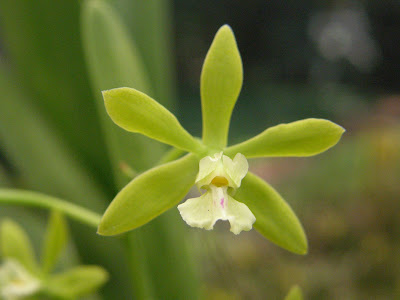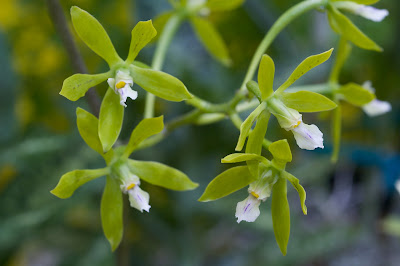Encyclia chloroleuca - Green and White Encyclia flowers are fragrant, long-lasting; sepals and petals greenish or yellowish, sometimes flushed with...
Encyclia chloroleuca, also called as Green and White Encyclia, Encyclia acuta, Encyclia amanda, Encyclia chloroleuca var. rubescens, Encyclia chloroleuca var. yotocoensis, Encyclia viridiflava, Epidendrum acutum, Epidendrum amandum, Epidendrum chloranthum, Epidendrum chloroleucum, is a species in the genus Encyclia. This species was described by Joseph Henri François Neumann in 1846.
DESCRIPTION OF ENCYCLIA CHLOROLEUCA - GREEN AND WHITE ENCYCLIA
Encyclia chloroleuca is native to Southern Mexico to Southern Tropical America. It is found growing on trees tropical wet forest, premontane belt transition, premontane wet forest and tropical wet forest in Belize, Brazil North, Colombia, Costa Rica, Ecuador, French Guiana, Guatemala, Guyana, Mexico Southeast, Mexico Southwest, Panamá, Peru, Suriname, Venezuela at elevations of 50-1300 meters above sea level.
It is a small sized, hot to cool growing epiphytic species which reaching 23-30 cm in height with fusiform to ovoid, mostly bifoliate, rugose, 1-4 x 0.8-3.5 cm pseudobulbs that are subtended by papery sheaths, shredded with age. The leaves are 2 to 3, apical, narrowly oblong-lorate, obtuse to shortly acute, coriaceous, glossy, basally clasping, 10-30 x 0.7-2.2 cm.
Green and White Encyclia blooms in late summer and the fall from the apical, to 30 cm long, simple, racemose, loosely 2-8 flowered inflorescences that arise from the mature pseudobulb. The flowers are about 3 cm in diameter, waxy, fragrant, long-lasting; sepals and petals greenish or yellowish, sometimes flushed with brown, lip white-cream marked with three to several magenta streaks on midlobe.
ENCYCLIA CHLOROLEUCA - GREEN AND WHITE ENCYCLIA CARE AND CULTURE
Cultural information should only be used as a guide, and should be to be adapted to suit you. Your physical location; where you grow your plants, how much time you have to devote to their care, and many other factors, will need to be taken into account. Only then can you decide on the cultural methods that best suit you and your plants.
Light:
Encyclia chloroleuca needs a light level of 25000-35000 lux. The light should be filtered or diffused and the plants should not be exposed to direct midday sun. Strong air movement should be provided all the time.
Temperature:
In summer, the average day temperature is 24-27 °C, and the night 14-16 °C, with a daily amplitude of 8-10 °C. In winter the average daytime temperatures are 23-25 °C, and 13-15 °C during the night, while the daily amplitude is 8-11 °C.
Humidity:
Green and White Encyclia needs the humidity of 80% in the period of growth, in winter and spring it falls to 60-70%. Too dry air has a negative effect on the development of the plant: its growth is inhibited, and the leaves begin to turn yellow and dry out. The higher temperature, the higher the humidity should be, and the higher the humidity, the more often and longer it is necessary to ventilate the room where the plants are contained, otherwise the probability of rotting and various kinds of fungal diseases. Good air movement is essential while the plants are in leaf and growing.
Substrate, growing media and repotting:
Encyclia chloroleuca are most often grown in pots or baskets with a very thick, loose and well-drained substrate. There should be plenty of space in the pots to allow the roots to dry quickly after watering. It is recommended to use smaller pots sufficient for only one or two years of growth, because the substrate in larger pots remains wet after watering for too long. Roots that do not dry out quickly enough after watering rot. Most growers recommend medium grain bark, though others prefer medium cork pieces mixed with large lumps of charcoal.
The plants also grow well mounted on tree-fern or cork rootstocks, provided that high humidity is ensured. Fixed plants require high humidity and at least daily watering in summer, and in the case of dry and hot weather, it may be necessary to water several times a day.
Transplanting or splitting is best done when new roots begin to emerge, or immediately after blooming. This allows the plants to acclimate in a relatively short time and provides them with the least stress.
Watering:
The plants should be watered abundantly during active growth, but their roots must dry out quickly after watering. At the end of autumn, the amount of water should be gradually reduced.
Fertilizer:
Green and White Encyclia should be fertilized every week 1/4-1/2 of the recommended dose of fertilizer for orchids. A fertilizer with a high nitrogen content is beneficial from spring to mid-summer, and a phosphorus-rich fertilizer can be used in late summer and autumn. Higher phosphorus content stimulates better flowering in the next season and promotes hardening of new growth before winter.
To avoid the accumulation of mineral deposits during periods of strong fertilization, it is recommended to rinse the containers approximately every month.
Rest period:
Encyclia chloroleuca grown in cool conditions should be kept relatively dry in winter, with occasional fogging between rare waterings. However, those grown in warmer conditions need more water and significant drying up between waterings. However, it must not be allowed keep them dry for a long time. Fertilization should be reduced or eliminated until new growths appear and watering begins more abundantly in the spring.















COMMENTS